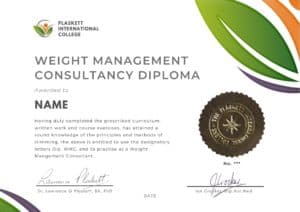
A message from the Author
As you enter into this study, I want you to be fully aware of what lies before you. If you save people from overweight, you will also increase life-expectancy and/or prevent the onset of serious debilitating diseases. There will also be those clients whose life has been long limited in a psychological sense and you will be able to help them to restore their sense of verve and vitality so they can again live life to the fullest extent. This will be done through learning special expertise both technically and in person-to-person relations. With these words of encouragement, I warmly welcome you to this course of study where the amount of potential job satisfaction is incalculable.

Dr. Lawrence Plaskett
Course Overview
The Plaskett Weight Management Consultancy course will provide you with a detailed, systematic and scientifically-based training, fuller than any other we know of in the field. It will enable you to practise as a well-informed Weight Management Consultant and most importantly, you will be able to help and support individuals in their quest to lose weight whilst maintaining health and well-being.
-
Learn the Basic Elements of Nutrition
You will gain an understanding of the basic elements of nutrition with a focus on the key nutrients in order to avoid deficiencies when working with weight loss clients.
-
Create Individualised Weight Loss Programmes
You will develop the confidence to be able to make informed choices from a wide span of weight loss options and avoid the use of rigidly fixed methods, thereby delivering programmes best suited to individual needs.
-
Become a Skilled Adviser
You will learn the skills to be able to counsel on a one-to-one basis, we believe that this favours the resolution of individual circumstances and problems. You will receive the training to see your clients through every stage of the process, thereby maximising their chances of success.
-
Expand Practice of Current Health Professionals
In addition to those wanting to set up practice as a Weight Management Consultant, this course is ideally suited to current health & fitness professionals looking to enhance their practice.
Why Choose Us?
Some reasons why our Weight Management Consultancy course sets us apart from others in the field:

Breakdown of the Course Sections
The Weight Management Consultancy Diploma includes the following 13 sections:
Testimonials
Here's what students have to say about the course

Pricing
Weight Management Consultancy Diploma
£475
- Lifetime Access to Course Material
- Full Tutor Support
- Diploma In Weight Management Consultancy upon Completion
- Instalment Option Available
F.A.Q.
Yes. As a guide, this course takes 9-12 months based on a part time study schedule of 3-5 hours per week however if you have more time to allocate to study, you can certainly complete the course sooner.
There are 3 short written assignments and 2 case studies to complete.
You will be awarded a Diploma in Weight Management Consultancy which will entitle you to use the letters Dip.WMC after your name.
Yes, it is accredited by the IICT (International Institute for Complementary Therapists).
If you would like a hard copy of the course material to complement your online studies, you can purchase this for £10 (p&p incl.)
We certainly think so, taking into account the huge interest in slimming expressed by the vast market for slimming products. Success will, of course, require some business ability in running and promoting your practice.
In addition to client's session fees, you can also earn from the sale of products with favourable trade margins on herbs & nutrients.
Note that after taking the course you are not beholden to anyone else, certainly not one of the large national or international companies. In some other systems, you have to pay a high proportion of your earnings to a franchiser and work as they tell you. Not with this course. You can be independent and keep all that you earn: a vastly important business advantage.


